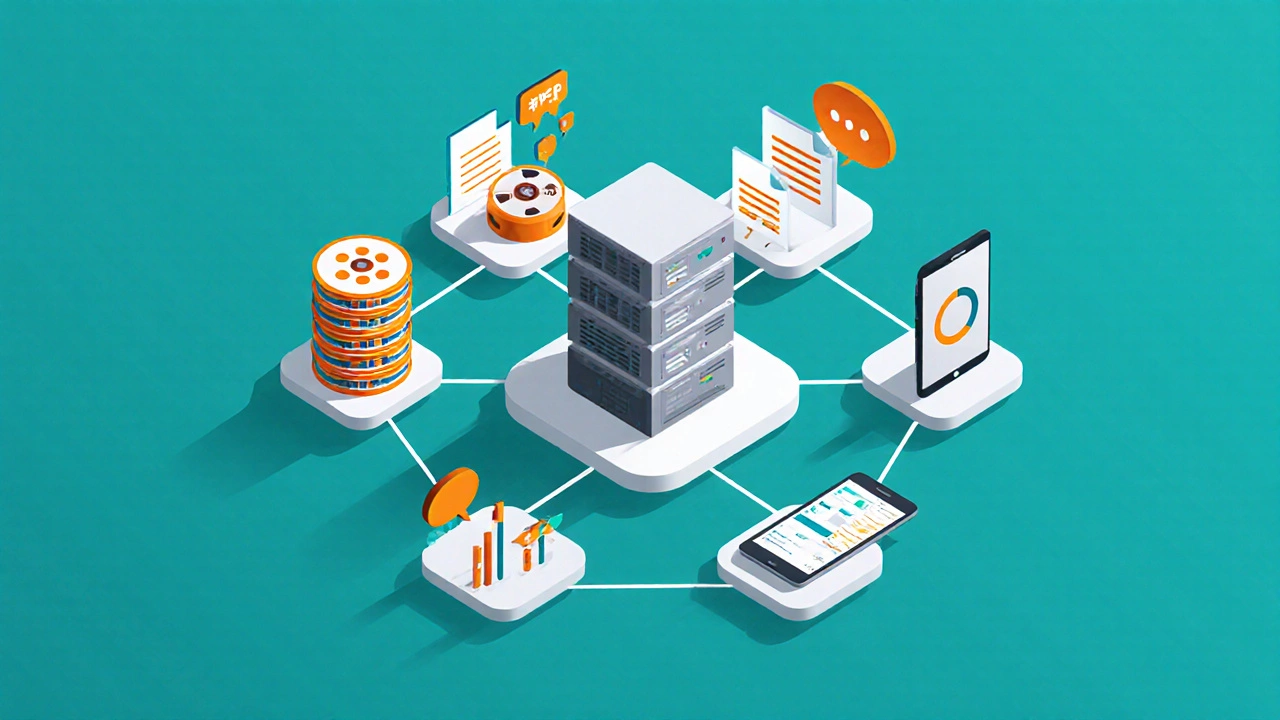When you hear the term e‑platform a digital system that delivers, manages, and tracks learning content over the internet, you might picture a fancy website or a video conference tool. In reality, an e‑platform is the backbone that ties together courses, assessments, student data, and interaction tools into a single, seamless experience. Think of it as the virtual campus where teachers post lessons, learners submit assignments, and administrators see real‑time performance metrics.
Core Components That Make Up an E‑Platform
Every robust e‑platform shares a handful of essential building blocks. Knowing these helps you recognize what to look for and why each piece matters.
- Learning Management System (LMS) - the engine that stores content, schedules classes, and records grades. Popular examples include Moodle, Canvas, and Blackboard.
- Content Library - video lectures, PDFs, quizzes, and interactive simulations that learners consume.
- Assessment Suite - tools for quizzes, assignments, proctoring, and automated grading.
- Communication Hub - discussion boards, chat, video conferencing, and announcements that keep everyone connected.
- Analytics Dashboard - visual reports on engagement, completion rates, and skill gaps, often powered by learning analytics.
- Mobile Compatibility - responsive design or dedicated apps so learners can study on phones and tablets.
These modules don’t operate in isolation. They feed data to each other, creating a feedback loop that improves instruction over time.
Different Types of E‑Platforms and When to Use Them
Not all e‑platforms are created equal. Below is a quick comparison of the most common varieties, their typical users, and key features.
| Type | Primary Audience | Typical Size | Key Strength | Typical Cost (2025) |
|---|---|---|---|---|
| Corporate LMS | Enterprises & NGOs | 10000+ users | Compliance tracking, scalability | US$15‑30 per user/yr |
| University VLE (Virtual Learning Environment) | Higher education | 5000‑20000 users | Research integration, grading flexibility | US$10‑20 per user/yr |
| MOOC Platform | Mass public learners | 100000+ users | Open enrollment, multimedia delivery | Free‑to‑pay, revenue share model |
| K‑12 Cloud Classroom | School districts | 500‑5000 users | Safety controls, parent portals | US$5‑12 per user/yr |
| Specialized Skill Platform | Professional up‑skilling | 1000‑10000 users | Adaptive learning, certification paths | US$20‑40 per user/yr |
Choosing the right type hinges on who will learn, how many will join, and what outcomes matter most.
Key Benefits That Make E‑Platforms Worth the Investment
Below are the top advantages that educators and organizations consistently report.
- Scalability - Add thousands of learners without needing new classrooms.
- Personalization - Adaptive learning engines recommend content based on each learner’s progress.
- Data‑Driven Decisions - Real‑time analytics reveal which modules are confusing or underused.
- Cost Reduction - Cut travel, printed material, and facility expenses.
- Flexibility - Learners study anytime, anywhere, on any device.
These benefits translate into higher completion rates, better skill retention, and a measurable ROI for businesses.

How to Pick the Right E‑Platform for Your Needs
When the market offers dozens of options, a systematic checklist helps you avoid costly missteps.
- Define Your Goals - Are you aiming for certification, compliance, or community building?
- Check Integration Compatibility - Does the platform talk to your existing HR system, SIS, or CRM?
- Evaluate User Experience - Test the interface with a small group of teachers and learners.
- Assess Support & Community - Look for active forums, documentation, and responsive vendor help.
- Budget Transparency - Understand licensing tiers, hidden fees, and upgrade costs.
- Security & Compliance - Verify GDPR, FERPA, or industry‑specific standards are met.
Apply these criteria in a simple scoring matrix, and you’ll see which platform rises to the top.
Step‑by‑Step Guide to Implementing an E‑Platform
Even a tech‑savvy organization can stumble during rollout. Follow these eight steps for a smoother launch.
- Stakeholder Alignment - Gather teachers, IT staff, and leadership to agree on objectives.
- Content Audit - Inventory existing courses, videos, and documents; decide what to migrate.
- Platform Configuration - Set up user roles, branding, and navigation menus.
- Integrate Third‑Party Tools - Connect video conferencing, plagiarism detection, and payment gateways.
- Pilot Test - Run a small cohort, collect feedback, and tweak workflows.
- Train Instructors - Offer hands‑on workshops on course authoring and analytics.
- Full Rollout - Open enrollment to all learners, monitor traffic spikes, and address bugs quickly.
- Continuous Improvement - Use learning analytics to refine content, update assessments, and celebrate milestones.
Stick to this roadmap, and you’ll see adoption rates climb within weeks rather than months.

Common Pitfalls and Pro Tips
Below are mistakes that sabotage e‑platform projects, paired with quick fixes.
- Pitfall: Overloading the platform with too many features.
Tip: Start with core LMS functions; add advanced modules only when you have proven need. - Pitfall: Ignoring mobile users.
Tip: Test every page on smartphones before launch; ensure videos have captions. - Pitfall: Poor data governance.
Tip: Assign a data steward to enforce naming conventions and privacy policies. - Pitfall: One‑size‑fits‑all content.
Tip: Use adaptive learning paths that branch based on quiz scores. - Pitfall: Lack of ongoing support.
Tip: Schedule monthly check‑ins with the vendor and internal power users.
Future Trends Shaping E‑Platforms
What will e‑platforms look like in the next five years? Here are three game‑changing directions.
- AI‑Driven Content Creation - Generative models can draft lesson scripts, create practice questions, and even produce captioned videos at scale.
- Immersive Learning - VR and AR modules will let learners practice surgeries, engineering assemblies, or language immersion in a virtual space.
- Micro‑Credential Ecosystems - Blockchain‑backed badges will certify skills across multiple platforms, giving learners portable proof of achievement.
Staying aware of these trends helps you future‑proof your investment and keep learners engaged.
In short, an e-platform is the digital foundation that turns scattered resources into a cohesive learning journey. Whether you run a corporate training program or a university department, understanding its parts, types, and best practices ensures you choose wisely and reap the full payoff of online education.
Frequently Asked Questions
What is the difference between an LMS and a VLE?
An LMS (Learning Management System) focuses on delivering courses, tracking progress, and handling assessments. A VLE (Virtual Learning Environment) adds tools for collaboration, research integration, and often a richer set of academic features suited to higher‑education institutions.
Can I use an e‑platform for both K‑12 and adult training?
Yes, many platforms are modular. You can enable parental controls and age‑appropriate content for K‑12 while activating certification pathways and skill‑tracking for adult learners.
How much does a typical e‑platform cost?
Pricing varies by type and scale. In 2025, corporate LMS solutions average US$15‑30 per user per year, while K‑12 cloud classrooms run around US$5‑12 per user annually. Open‑source options can be free but may require internal hosting and support costs.
Do I need technical staff to run an e‑platform?
For cloud‑based SaaS solutions, minimal IT involvement is needed-mostly for user management and integration. Self‑hosted platforms, however, require a server admin, security patches, and backups.
What security standards should an e‑platform meet?
Look for GDPR compliance for European users, FERPA for U.S. educational data, ISO/IEC 27001 for information security, and regular third‑party penetration testing.
